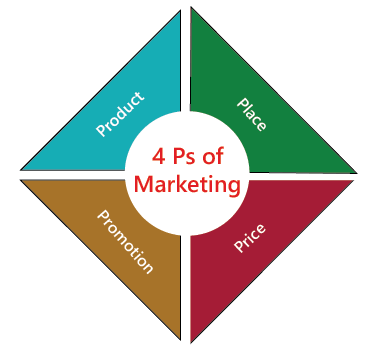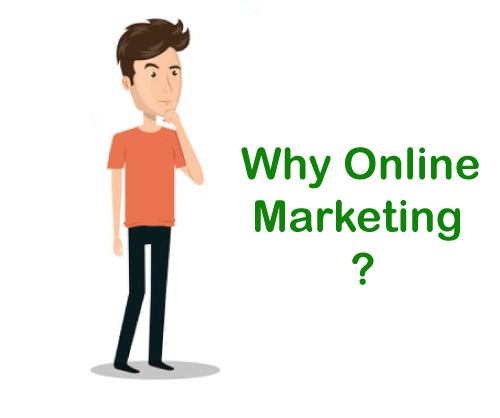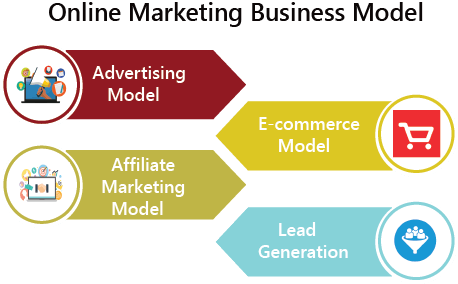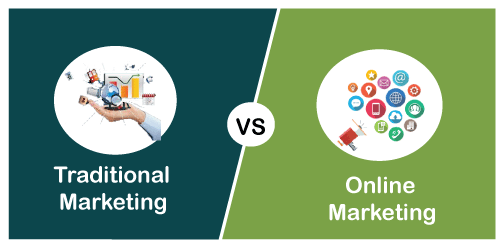Online MarketingMarketing is the process of communicating, understanding, creating, and delivering the relevant product to customers as per their requirement. There are two types of Marketing -
Marketing totally depends upon the 4 Ps. These four Ps are: 
1. ProductProduct is the root of marketing. A product can be anything tangible as well as intangible goods or services that a marketer offers to its customers to satisfy their needs. Note: Tangible products are those products that have a physical presence, which means that we can touch, feel, or smell these products. Example: vehicle, gadgets, etc. Intangible products are those that do not have a physical presence means we cannot touch, feel, or smell these products. Example: travel, insurance, computer software, health care, etc. 2. PlacePlace is the platform from which marketers present their products in front of customers and customers can purchase these products according to their needs. 3. PricePrice is one of the most important Ps in marketing. Price is the major influencing element for customers. It is the cost that a customer pays to a marketer for a specific product or a service. The product's price depends on the brand and the availability of the product. 4. PromotionPromotion is the method which is used to provide information about the product. Promotion includes various communication activities, advertising sites, social media marketing, email marketing, video marketing, brand awareness, and more to make the customer aware of the product. Now, before learning about Online Marketing, we first need to understand about traditional marketing. What is Traditional Marketing?Traditional Marketing is a type of marketing that helps marketers to reach target customers using various offline advertising and promotional methods. Traditional Marketing includes the following 5 major categories -
In our Online Marketing tutorial, we are going to discuss the following topics -
What is Online Marketing?Online marketing is also known as web marketing, digital marketing, internet marketing, and search engine marketing. It is web-based marketing which offers various set of tools to promote products and services through the internet to reach the target customers. Online marketing includes the following to reach the target customers -
Simply, we can say that online marketing is an art of selling products and services to customers using various digital networks such as internet or cellular phone networks. Online Marketing TerminologyThere are the following terms that we generally used in online marketing - AdvertiserAn Advertiser is also referred as merchant or retailer. An advertiser may be a person or organization that advertises Advertisements in order to target audience. BannerBanner is based on the graphical image and displayed on a web page. The below table shows the size, style, and Gif weight of banners -
PublisherPublisher is responsible for printing and publishing the advertisements. BidBid is the highest price that an advertiser is willing to pay for each click on the advertisement. Black Hat TacticsBlack Hat Tactics is used to increase page ranking and site ranking in search results. Good black hat tactics include keyword stuffing cloaking using a private link network. White Hat TacticsWhite Hat Tactics is used to improve our search ranking on the search engine results page and also makes our sites easy to navigate. Breadcrumbs NavigationBreadcrumbs Navigation is the part of a webpage which is used by the users to track their location from currently viewed page to home page of their website. The advantage of using Breadcrumbs Navigation is that it increases the user experience on the site. Click Through Rate (CTR)In Online Marketing, CTR is measured by using the numbers of clicks that our ad receives divide by a number of impressions. The below formula is used to measure the Click Through Rate (CTR).
Click Through Rate (CTR) = Clicks / Impressions %
Cost Per Acquisition (CPA) Cost Per Acquisition is also referred as Cost Per Action. It is used to measure the aggregate cost to acquire one paying customer on a campaign. We can calculate CPA using below formula - 
Cost Per Click (CPC) Cost Per Click is also referred as Pay Per Click (PPC). It is the cost that we pay for each click on PPC marketing platforms. Some PPC platforms include Google Adword or Bing Advertisements (Ads). CPC is calculated using the below formula - 
Cost Per Mile (CPM) Cost Per Mile is also referred as Cost Per Thousand (CPT). It is the most common term used in online marketing. CPM is used to measure the cost that an advertiser pays for one thousand clicks. If This Then Than (IFTTT) It is a conditional programming statement launched in 2011. Using IFTTT, we can turn on or off an applet and it also us to create our own applets. Key Performance Indicator (KPI) Key Performance Indicator (KPI) is used to measure the effectiveness of an organization. Search Engine Optimization (SEO) SEO is the process of acquiring and increasing the quality as well as quantity of traffic on our website through organic, free, or natural search results on search engines. Some common search engines are Google, Yahoo, and Bing. Web Indexing Web Indexing is the process of creating indexes for individual web sites, collections of websites, and collections of HTML documents. Note: The term index refers to the systematical arrangement of items according to their names and topics.The biggest advantage of using web indexing is that it helps customers to find the wanted content easily on the Internet. Tracking Tracking is the most common word used in online marketing. It is a process of measuring the effectiveness of online advertising by collecting information. Quality Score (QS) Quality Score is used by organizations to analyze the effectiveness of Ads. It analyzes the effectiveness of ads based on the quality of the ad and landing page experience. Paid Search Advertising Paid Search Advertising is also known as Pay Per Click (PPC) Advertising. It is the advertising process in which the advertiser pays for each click on the Advertisements (Ads). Inbound Link Inbound link is also called a black link. It is a type of hyperlink on a third-party web page that actually points to a web page on your site. Why Online Marketing?
There are the following reasons to use Online Marketing -
Types of Online Marketing
There are the following different types of Online Marketing - 1. Search Engine Marketing (SEM)Search Engine Marketing (SEM) is the most important type of Online Marketing. It helps us to increase online marketing growth by purchasing Advertisements (Ads) on search engines like Google, Bing, or Yahoo. Search Engine Marketing depends upon the following factors -
2. Social Media Marketing (SMM)Social Media Marketing is the process of increasing our business's brand awareness, relationships, and website traffic using various social media platforms such as Facebook, Instagram, YouTube, LinkedIn, and Twitter. There are the following five pillars of Social Media Marketing -
3. Pay Per Click (PPC) AdvertisingPay Per Click advertisement is used by both customers as well as advertisers. It helps customers to reach their target customers by offering various services, including Search Advertising, Display Advertising, Social Media Advertising, Mobile Advertising, Google Shipping Ads, Keyword Discovery, and website traffic. 4. RemarketingRemarketing is used to promote specific products over the Internet. There are the following different types of Remarketing - Video Remarketing - It is used to display ads on YouTube. Search Remarketing - It is used to display the result at the top of the search engine when users already visited your site for specific services. Display Remarketing - It is used to display ads within the Google display ad network. Dynamic Remarketing - It is used to show our previous visitor's ads with products or services. Social Media Remarketing - Social media marketing uses various social media platforms such as Facebook, YouTube, and LinkedIn to serve ads to the target audience. Customer List Remarketing - It is used in both Google Adwords remarketing and social media marketing 5. Content MarketingContent marketing is the process of creating, publishing, and distributing the relevant content to their target customer in order to attract, acquire, and engage them. Content marketing includes infographics, Webpages, Podcasts, Videos, Books, and bogs to aware and attracts customers about the product. 6. Affiliate MarketingAffiliate Marketing is the most popular way to make money online. Affiliate marketers promote various products from many different companies to earn commissions. 7. Email MarketingNowadays, email marketing becomes one of the most important online marketing. It is a highly effective online marketing strategy that contains information about specific products, discount offers, free advertisements, and deals to build relationships with customers. The main advantage of using email marketing is that it allows us a flexible and cost-effective way of reaching new customers. 8. Mobile MarketingMobile Marketing is the process of promoting business using mobile devices such as cell phones, smartphones, e-books, tablets, and others. According to a survey, mobile marketing industries grow from $160 million in 2008 to $3.1 billion in 2013. Mobile Marketing includes the following -
Advantages of Online MarketingIn the digital era, marketing is incomplete without Online Marketing. It helps both small and large organizations to grow their business using online advertisements. A list of advantages of Online Marketing is given below - 1. 24*7 Marketing Services availableOnline marketing offers services 24 hours a day and 7 days a week to customers. Thus, it saves customers time that they physically spend in shopping. 2. Global reachOnline marketing allows us to interact with new marketers and customers globally. 3. Large number of customersOnline Marketing deals with a huge number of online customers. Online marketers reach their target audience using various social media platforms such as Facebook, YouTube, Twitter, and Instagram. Marketers continuously send messages to customers related to specific brands, products, as well as based on their interests. 4. Higher Quality website trafficOnline Marketing used social media marketing and paid advertisement strategy to gain higher quality website traffic. As we know, that higher quality of traffic equals to higher money. 5. Long-Lasting RelationshipOnline marketing is used to build a long-lasting relationship with the target customer. With online marketing, marketers can easily communicate with the customer using emails and also capable of sending them emails related to the product's brand, discounts offers, and special offers for special events. 6. Wider ChoiceWider choice is one of the biggest advantages of Online Marketing. Online Marketing allows customers to see a wide variety of products at the same place, which helps customers to quickly fulfill their requirements. 7. Enhanced consumer satisfactionUsing Online Marketing, a customer easily gets information about a product, its features, and services by click on a button. So it helps customers to make a better and quick decision. 8. Social Media PlatformsSocial media platform provides a powerful way for organizations to reach their target customers. Using Social media platforms, marketers post various images, text, audio, and video content to attract customers and grow their business. Disadvantages of Online MarketingThere are the following disadvantages of Online Marketing -
Online Marketing Business ModelsOnline marketing focuses on the following business models - 
1. Advertising ModelAdvertising model uses various advertising mediums to reach the target customer. Some most common advertising models are: Cost Per Click (CPC) or Pay Per Click (PPC), Cost Per Action (CPA) or Cost Per Acquisition, Value Per Action (VPA), Cost per Impression (CPI), shared CPM, and Click Through Rate (CTR) 2. E-commerce ModelE-commerce is also referred as Electronic commerce or internet commerce. It is the process of selling and buying goods as well as services using the internet connection. Some popular eCommerce platforms are Shopify, WooCommerce, BigCommerce, Magento, Wix, and Squarespace. There are the following types of Ecommerce model -
3. Affiliate marketing modelAffiliate marketing is one of the most successful online marketing business models. It is the process of referring to the services and products by using blogs, social media platforms, and websites. The affiliate gets a commission each time when someone purchases through the unique link associated with their recommendation. Affiliate marketing model depends upon the following -
4. Lead Generation ModelLead generation model is used to describe the marketing process. Lead generation model helps you answer the following question -
There are the following types of leads -
Difference between Traditional Marketing and Online Marketing
The below table shows the difference between Traditional Marketing and Online Marketing -
Next TopicSEO
|
 For Videos Join Our Youtube Channel: Join Now
For Videos Join Our Youtube Channel: Join Now
Feedback
- Send your Feedback to [email protected]
Help Others, Please Share










